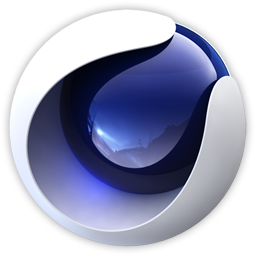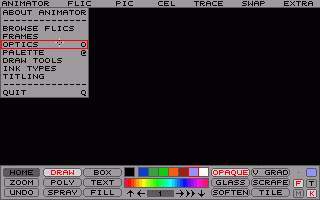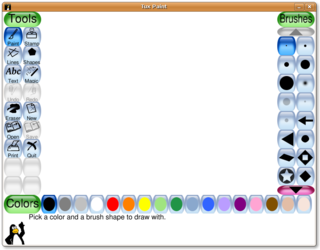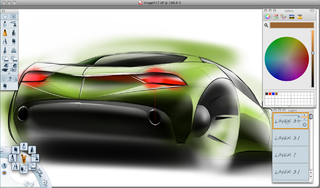Autodesk, Inc. is an American multinational software corporation that makes software products and services for the architecture, engineering, construction, manufacturing, media, education, and entertainment industries. Autodesk is headquartered in San Francisco, California, and has offices worldwide. Its U.S. offices are located in the states of California, Oregon, Colorado, Texas, Michigan, New Hampshire and Massachusetts. Its Canada offices are located in the provinces of Ontario, Quebec, and Alberta.

Cinema 4D is a 3D software suite developed by the German company Maxon.

Houdini is a 3D animation software application developed by Toronto-based SideFX, who adapted it from the PRISMS suite of procedural generation software tools.

Softimage, Co. was a company located in Montreal, Quebec, Canada that produced 3D animation software. A subsidiary of Microsoft in the 1990s, it was sold to Avid Technology, who would eventually sell the name and assets of Softimage's 3D-animation business to Autodesk.

Bryce, also often referred to colloquially as Bryce3D, is a 3D modeling, rendering and animation program specializing in fractal landscapes. The name is taken from Bryce Canyon—a rugged region with many of the same landscapes that were first simulated with the software.

Autodesk Animator is a 2D computer animation and painting program published in 1989 for MS-DOS. It was considered groundbreaking when initially released.
Autodesk Media and Entertainment is a division of Autodesk which offers animation and visual effects products, and was formed by the combination of multiple acquisitions. In 2018, the company began operating as a single operating segment and reporting unit.
In computer graphics, graphics software refers to a program or collection of programs that enable a person to manipulate images or models visually on a computer.

Autodesk Softimage, or simply Softimage was a 3D computer graphics application, for producing 3D computer graphics, 3D modeling, and computer animation. Now owned by Autodesk and formerly titled Softimage|XSI, the software has been predominantly used in the film, video game, and advertising industries for creating computer generated characters, objects, and environments.

Tux Paint is a free and open source raster graphics editor geared towards young children. The project was started in 2002 by Bill Kendrick who continues to maintain and improve it, with help from numerous volunteers. Tux Paint is seen by many as a free software alternative to Kid Pix, a similar proprietary educational software product.
An image file format is a file format for a digital image. There are many formats that can be used, such as JPEG, PNG, and GIF. Most formats up until 2022 were for storing 2D images, not 3D ones. The data stored in an image file format may be compressed or uncompressed. If the data is compressed, it may be done so using lossy compression or lossless compression. For graphic design applications, vector formats are often used. Some image file formats support transparency.

Sketchbook is a raster graphics software app intended for expressive drawing and concept sketching also for making animations. The software was first developed by Alias Systems Corporation as StudioPaint, before being acquired by Autodesk and then being spun out into an independent company, Sketchbook, Inc. Originally developed as commercial software, it evolved into a subscription model before eventually being made freeware for personal use. In 2021, Sketchbook Pro, the desktop version of the app available on Microsoft Windows and macOS, became a paid software available through the Microsoft Store and Mac App Store.

The ULULU Company, also known as The Curiosity Company for secondary branding, is an American production company and animation studio founded in 1997 by Matt Groening, creator of The Simpsons, for Gracie Films. It produces the television series Futurama and Disenchantment and the 1999 television film Olive, the Other Reindeer. Groening revived the name The Curiosity Company in 2023.

Toon Boom Animation Inc., also known as Toon Boom, is a Canadian software company founded in 1994 and based in Montreal, Quebec. It specializes in the development and production of animation and storyboarding software for film, television, the World Wide Web, video games, mobile devices, training and education.

Softimage|3D was a high-end 3D graphics application developed by Softimage, Co., which was used predominantly in the film, broadcasting, gaming, and advertising industries for the production of 3D animation. It was superseded by Softimage XSI in 2000.
RETAS is a 2D animation software bundle developed and sold by Celsys that is available for Microsoft Windows and Mac OS X. It handles the entire animation production from digitally drawing or tracing to exporting in Flash and QuickTime, and is considered to be a leader in Japan's anime industry including Toei Animation. RETAS was later succeeded by Clip Studio Paint.
OpenRaster is a file format proposed for the common exchange of layered images between raster graphics editors. It is meant as a replacement for later versions of the Adobe PSD format. OpenRaster is still in development and so far is supported by a few programs. The default file extension for OpenRaster files is ".ora".
The history of computer animation began as early as the 1940s and 1950s, when people began to experiment with computer graphics – most notably by John Whitney. It was only by the early 1960s when digital computers had become widely established, that new avenues for innovative computer graphics blossomed. Initially, uses were mainly for scientific, engineering and other research purposes, but artistic experimentation began to make its appearance by the mid-1960s – most notably by Dr. Thomas Calvert. By the mid-1970s, many such efforts were beginning to enter into public media. Much computer graphics at this time involved 2-D imagery, though increasingly as computer power improved, efforts to achieve 3-D realism became the emphasis. By the late 1980s, photo-realistic 3-D was beginning to appear in film movies, and by mid-1990s had developed to the point where 3-D animation could be used for entire feature film production.

Art of Illusion is a free software, and open source software package for making 3D graphics.








